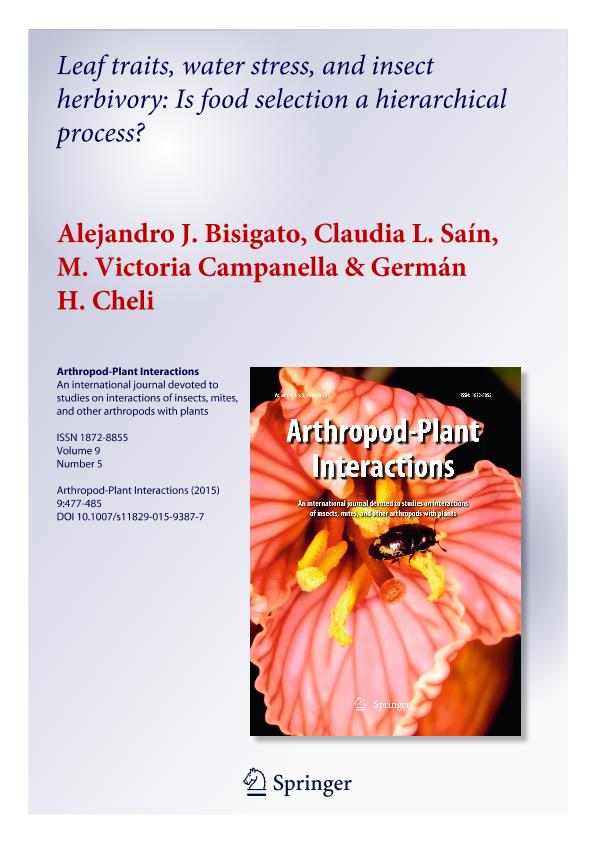Mostrar el registro sencillo del ítem
dc.contributor.author
Bisigato, Alejandro Jorge

dc.contributor.author
Sain, Claudia Leticia

dc.contributor.author
Campanella, María Victoria

dc.contributor.author
Cheli, German Horacio

dc.date.available
2018-03-26T20:57:07Z
dc.date.issued
2015-10
dc.identifier.citation
Bisigato, Alejandro Jorge; Sain, Claudia Leticia; Campanella, María Victoria; Cheli, German Horacio; Leaf traits, water stress, and insect herbivory: Is food selection a hierarchical process?; Springer; Arthropod-plant Interactions; 9; 5; 10-2015; 477-485
dc.identifier.issn
1872-8855
dc.identifier.uri
http://hdl.handle.net/11336/40062
dc.description.abstract
Plant water stress can affect selectivity by insect herbivores. Numerous studies have shown greater insect preference for water-stressed plants, but others have reported the opposite response. We evaluated leaf consumption by adults of Nyctelia circumundata (a chewing insect) in leaves of Larrea divaricata and Prosopis alpataco. Three bioassays (two-way choice tests) were performed: two intra-specific comparisons between well-watered (+W) and water-stressed (−W) leaves of each species and one inter-specific comparison between leaves of the two species. Leaf biomass was reduced by water stress in both species. Nitrogen concentration in leaves (N) was reduced by drought in P. alpataco. In contrast, total phenolics and specific leaf area (SLA) did not differ between treatments within species. Nyctelia circumundata did not show preference by any water supply regimes in intra-specific comparisons. In contrast, in inter-specific choice tests, it showed a marked preference for P. alpataco, which is the species with the highest nitrogen concentration and lowest total phenolics concentration. In intra-specific comparisons, maximum leaf consumption was inversely related to SLA in both species. Furthermore, in P. alpataco, N concentration was positively related to maximum leaf consumption and negatively related to leaf water content (LWC). In contrast, in inter-specific comparisons, total phenolics was negatively related to maximum leaf consumption, while N concentration exhibited the opposite trend. These results suggest that food selection is a hierarchical process where chemical attributes (i.e., total phenolics and N) are taken into account for species selection, and physical attributes (i.e., SLA and LWC) for choosing individuals inside species.
dc.format
application/pdf
dc.language.iso
eng
dc.publisher
Springer

dc.rights
info:eu-repo/semantics/openAccess
dc.rights.uri
https://creativecommons.org/licenses/by-nc-sa/2.5/ar/
dc.subject
Consumption
dc.subject
Drought
dc.subject
Larrea Divaricata
dc.subject
Nyctelia Circumundata
dc.subject
Prosopis Alpataco
dc.subject.classification
Otras Ciencias Biológicas

dc.subject.classification
Ciencias Biológicas

dc.subject.classification
CIENCIAS NATURALES Y EXACTAS

dc.title
Leaf traits, water stress, and insect herbivory: Is food selection a hierarchical process?
dc.type
info:eu-repo/semantics/article
dc.type
info:ar-repo/semantics/artículo
dc.type
info:eu-repo/semantics/publishedVersion
dc.date.updated
2018-03-12T17:54:05Z
dc.identifier.eissn
1872-8847
dc.journal.volume
9
dc.journal.number
5
dc.journal.pagination
477-485
dc.journal.pais
Alemania

dc.journal.ciudad
Berlin
dc.description.fil
Fil: Bisigato, Alejandro Jorge. Consejo Nacional de Investigaciones Científicas y Técnicas. Centro Nacional Patagónico; Argentina. Universidad Nacional de la Patagonia; Argentina
dc.description.fil
Fil: Sain, Claudia Leticia. Consejo Nacional de Investigaciones Científicas y Técnicas. Centro Nacional Patagónico; Argentina
dc.description.fil
Fil: Campanella, María Victoria. Consejo Nacional de Investigaciones Científicas y Técnicas. Centro Nacional Patagónico; Argentina
dc.description.fil
Fil: Cheli, German Horacio. Consejo Nacional de Investigaciones Científicas y Técnicas. Centro Nacional Patagónico; Argentina
dc.journal.title
Arthropod-plant Interactions

dc.relation.alternativeid
info:eu-repo/semantics/altIdentifier/doi/http://dx.doi.org/10.1007/s11829-015-9387-7
Archivos asociados
